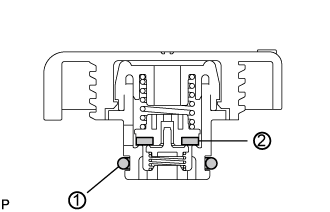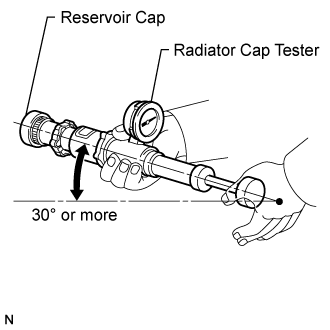Land Cruiser URJ200 URJ202 GRJ200 VDJ200 - 1VD-FTV COOLING
RADIATOR - ON-VEHICLE INSPECTION
| 1. INSPECT RADIATOR RESERVOIR CAP |

- CAUTION:
- Do not remove the radiator reservoir cap while the engine and radiator are still hot. Pressurized, hot engine coolant and steam may be released and cause serious burns.
Measure the valve opening pressure.
If there are water stains or foreign matter on O-ring 1, clean it with water and finger scouring.
Check that O-ring 1 is not deformed, cracked or swollen.
Apply engine coolant to O-ring 1 and rubber packing 2.

Prepare a radiator cap tester, and tilt it more than 30°.
Pump the cap tester several times, and check the maximum pressure*.
- Pumping speed:
- 1 pump per second
- HINT:
- *: Even if the cap cannot maintain the maximum pressure, it is not a defect.
- Standard Judgment Criterion:
Item Specified Condition Standard value
(for brand-new cap)93 to 123 kPa (1.0 to 1.3 kgf/cm2, 13.5 to 17.8 psi) Minimum standard value
(after using cap)78.5 kPa (0.8 kgf/cm2, 11.4 psi)
If the maximum pressure is less than the minimum standard value, replace the radiator reservoir cap sub-assembly.
| 2. INSPECT FINS FOR BLOCKAGE |
Check that the radiator and condenser are not blocked with leaves, dirt, or insects. Clean the hose connections.
If the fins are blocked, wash them with water or a steam cleaner.
- NOTICE:
If the distance between the steam cleaner and core is too close, the fins may be damaged.
Keep the following injection distance.
- Standard Injection Distance:
Injection Distance Injection Pressure 300 mm (11.8 in.) 2942 to 4903 kPa (30.0 to 50.0 kgf/cm2, 427 to 711 psi) 500 mm (19.7 in.) 4903 to 7845 kPa (50.0 to 80.0 kgf/cm2, 711 to 1138 psi)
If the fins are bent, straighten them with a screwdriver or pliers.
Never apply water directly onto the electric components.
Dry the fins with compressed air.